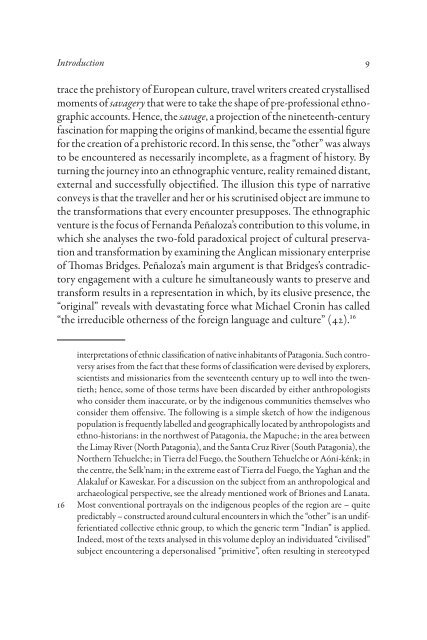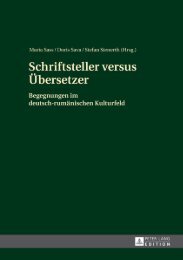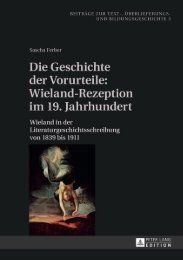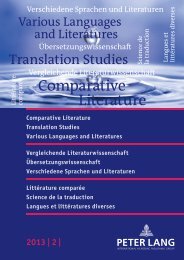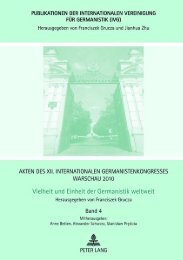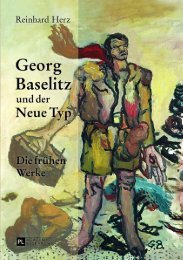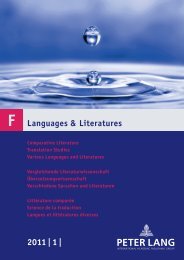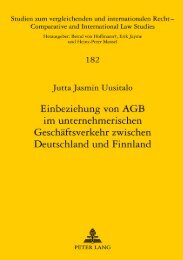Extract (PDF) - Peter Lang
Extract (PDF) - Peter Lang
Extract (PDF) - Peter Lang
Create successful ePaper yourself
Turn your PDF publications into a flip-book with our unique Google optimized e-Paper software.
Introduction 9<br />
trace the prehistory of European culture, travel writers created crystallised<br />
moments of savagery that were to take the shape of pre-professional ethnographic<br />
accounts. Hence, the savage, a projection of the nineteenth-century<br />
fascination for mapping the origins of mankind, became the essential figure<br />
for the creation of a prehistoric record. In this sense, the “other” was always<br />
to be encountered as necessarily incomplete, as a fragment of history. By<br />
turning the journey into an ethnographic venture, reality remained distant,<br />
external and successfully objectified. The illusion this type of narrative<br />
conveys is that the traveller and her or his scrutinised object are immune to<br />
the transformations that every encounter presupposes. The ethnographic<br />
venture is the focus of Fernanda Peñaloza’s contribution to this volume, in<br />
which she analyses the two-fold paradoxical project of cultural preservation<br />
and transformation by examining the Anglican missionary enterprise<br />
of Thomas Bridges. Peñaloza’s main argument is that Bridges’s contradictory<br />
engagement with a culture he simultaneously wants to preserve and<br />
transform results in a representation in which, by its elusive presence, the<br />
“original” reveals with devastating force what Michael Cronin has called<br />
“the irreducible otherness of the foreign language and culture” (42).16<br />
interpretations of ethnic classification of native inhabitants of Patagonia. Such controversy<br />
arises from the fact that these forms of classification were devised by ex plorers,<br />
scientists and missionaries from the seventeenth century up to well into the twentieth;<br />
hence, some of those terms have been discarded by either anthro pologists<br />
who consider them inaccurate, or by the indigenous communities themselves who<br />
consider them offensive. The following is a simple sketch of how the indigenous<br />
population is frequently labelled and geographically located by anthropologists and<br />
ethno-historians: in the northwest of Patagonia, the Mapuche; in the area between<br />
the Limay River (North Patagonia), and the Santa Cruz River (South Patagonia), the<br />
Northern Tehuelche; in Tierra del Fuego, the Southern Tehuelche or Aóni-kénk; in<br />
the centre, the Selk’nam; in the extreme east of Tierra del Fuego, the Yaghan and the<br />
Alakaluf or Kaweskar. For a discussion on the subject from an anthropological and<br />
archaeological perspective, see the already mentioned work of Briones and Lanata.<br />
16 Most conventional portrayals on the indigenous peoples of the region are – quite<br />
predictably – constructed around cultural encounters in which the “other” is an undifferientiated<br />
collective ethnic group, to which the generic term “Indian” is applied.<br />
Indeed, most of the texts analysed in this volume deploy an individuated “civilised”<br />
subject encountering a depersonalised “primitive”, often resulting in stereotyped


